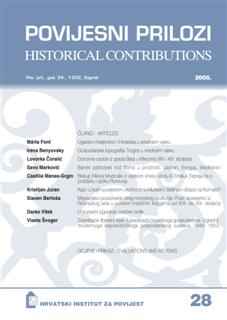Kad i u kojim povijesnim okolnostima Murterini i Betinjani dolaze na Kornate?
When and under which circumstances did the people from Murter and Betina arrive to Kornati?
Author(s): Kristijan JuranSubject(s): History
Published by: Hrvatski institut za povijest
Keywords: Kornats; Murter; Betina; shepherds; pastures; 17th century; Candian war
Summary/Abstract: Kornati islands are still, as they were for most of the time in the past, a locality without permanent settlements, and specific, temporary and sporadic settlements depended on nature and agricultural possibilities. The basis of economic exploitation of Kornati soil were its large pasture lands, while agriculture was limited to a rather small area of fertile loose ground. The shepherds and farm laborers who worked on Kornati lived in the settlements on the neighboring islands. These were usually the people from Sali, Luka and Žman on Dugi otok, and later people from Murter and Betina. Kornati were under the jurisdiction of Zadar and the Chamber of Zadar leased it on public auctions. That was the case until 1639 when Kornati were sold to four noblemen from Zadar together with many other surrounding islands. Around mid 17th century, shepherds left the isles of Kornati with their cattle due to pirate attacks at the beginning of the Cretan war (1645- 1699). Disagreements on legal issues and matters of inheritance between owners and land beneficiaries contributed to slow recovery of the economic conditions of Kornati. People from Murter took advantage of the situation and replaced the shepherds from Žman by bringing their cattle on the deserted pastures of Kornati in 1650s. New relations between owners and pasture beneficiaries were legally sanctioned with a 1654 lease contract between the owner of the northwestern Kornat island (family Soppe and Califfi) and the pastor of Murter, Ivo Skračić and his associate Ivo Gverini who was, by all indications, from Sali. They subleased parts of the pastures to people from Murter and Betina. Around that time, the latter took their cattle to the southeastern Kornat and Žut and Sit islands. A part of Žut pastures were still under the tenancy of Žman shepherds. The reason why shepherds from quite distant Murter occupied Kornati pastures is that the island of Murter was densely populated even in the second half of the 16th century so the island population grew and soon lost its pastures with intense clearing of groves and small surrounding rocky islands. From the beginning of the 17th century, the lack of pastures was compensated by leasing pastures on other near-by islands (Kaprije, Kakan, Gangarol, Žižanj, Košara, etc.) and finally, from the mid 17th century, by leasing the isles of Kornati. A coherent answer to the same question requires a more detailed analysis of socio-economic circumstances of a wider area which one of our future researches might examine.
Journal: Povijesni prilozi
- Issue Year: 2005
- Issue No: 28
- Page Range: 135-151
- Page Count: 17
- Language: Croatian

